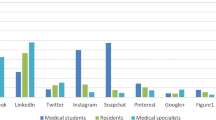Abstract
INTRODUCTION
Unprofessional online behavior by medical students or physicians may damage individual careers, and the reputation of institutions and the medical profession. What is considered unprofessional online behavior, however, is not clearly defined and may vary in different cultures.
OBJECTIVES
To determine the frequency with which students from a Brazilian Medical School come across ten given examples of unprofessional online behavior by medical students or physicians, and gather the opinions of participants regarding the appropriateness of these behaviors.
METHODS
A cross-sectional survey of 350 students from the Medical School of Bahia, Brazil. Only those who had a profile in social media were included in the final analyses.
RESULTS
336/350 (96.0 %) medical students kept a profile in social media. Only 13.5 % reported having discussions about online professionalism during ethics classes. They reported witnessing the investigated examples of unprofessional online behavior with varying frequencies, ranging from 13.7 % for “violation of patient’s privacy” to 85.4 % for “photos depicting consumption of alcoholic beverages”. Most participants felt neutral about posting “pictures in bathing suits”, whereas the vast majority rated “violation of patient’s privacy” as totally inappropriate. When presented with a case vignette illustrating violation of patients’ privacy (publication of pictures of hospitalized children or neonates in social media), however, most participants felt neutral about it. Participants considered all investigated examples of unprofessional online behavior more inappropriate if carried out by doctors rather than by students.
CONCLUSIONS
Medical students are witnessing a high frequency of unprofessional online behavior by their peers and physicians. Most investigated behaviors were considered inappropriate, especially if carried out by physicians. Participants were not able to recognize the publication of pictures of hospitalized children or neonates in social media as cases of violation of patients’ privacy. Further studies are needed to determine if an academic curriculum that fosters online professionalism will change this scenario.

Similar content being viewed by others
REFERENCES
Thompson LA, Dawson K, Ferdig R, et al. The Intersection of Online Social Networking with Medical Professionalism. J Gen Intern Med. 2008; 23: 954–7.
Greysen SR, Kind T, Chretien KC. Online Professionalism and the Mirror of Social Media. J Gen Intern Med. 2010; 25: 1227-9
Chretien KC, Greysen SR, Chretien JP, Kind T. Online Posting of Unprofessional Content by Medical Students. JAMA. 2009; 302:1309-15.
Thompson LA, Black E, Duff WP, Black NP, Saliba H, Dawson K. Protected Health Information on Social Networking Sites: Ethical and Legal Considerations. J Med Internet Res. 2011; 13: e8.
Chretien KC, Azar J, Kind T. Physicians on Twitter. JAMA. 2011; 305: 566-8.
Lagu T, Kaufman EJ, Asch DA, Armstrong K. Content of Weblogs Written by Health Professionals. J Gen Intern Med. 2008; 23:1642-6.
Greysen SR, Chretien KC, Kind T, Young A, Gross CP. Physician Violations of Online Professionalism and Disciplinary Actions: A National Survey of State Medical Boards. JAMA. 2012; 307: 1141-2.
American Medical Association (AMA). AMA Policy: Professionalism in the Use of Social Media. Available at: http://www.adventisthealthnw.com/amcp_resources/ccurl/800/160/AMA-Professionalism-in-use-of-Social-Media-7-25-11.pdf. Accessed November 04, 2013.
Federation of State Medical Boards of the United States. Model Guidelines for the Appropriate Use of the Internet in Medical Practice. Available at: http://www.fsmb.org/pdf/2002_grpol_Use_of_Internet.pdf. Accessed November 04, 2013.
Farnan JM, Sulmasy LS, Worster BK, Chaudhry HJ, Rhyne JA, Arora VM. Online Medical Professionalism: Patient and Public Relationships: Policy Statement From the American College of Physicians and the Federation of State Medical Boards. Ann Intern Med. 2013; 158: 1-8.
Shore R, Halsey J, Shah K, Crigger BJ, Douglas SP; AMA Council on Ethical and Judicial Affairs (CEJA). Report of the AMA Council on Ethical and Judicial Affairs: professionalism in the use of social media. J Clin Ethics. 2011; 22:165-72.
Instituto Brasileiro de Opinião Pública e Estatística. Total de pessoas com acesso à Internet atinge 77.8 milhões. Available at: http://www.ibope.com.br/pt-br/noticias/Paginas/Total de pessoas com acesso à internet atinge 77,8 milhões.aspx. Accessed November 04, 2013.
von Muhlen M, Ohno-Machado L. Reviewing Social Media Use by Clinicians. J Am Med Inform Assoc. 2012; 19:777-81.
Peluchette J, Karl K. Social Networking Profiles: An Examination of Student Attitudes Regarding Use and Appropriateness of Content. Cyberpsychol Behav. 2008; 11:95-7.
Osman A, Wardle A, Caesar R. Online professionalism and Facebook – Falling through the generation gap. Med Teach. 2012; 34: e549-56.
Australian Medical Association (AMA). Social Media and the Medical Profession: A Guide to Online Professionalism for Medical Practitioners and Medical Students. Available at: https://ama.com.au/social-media-and-medical-profession. Accessed November 04, 2013.
Greysen SR, Johnson D, Kind T, et al. Online Professionalism Investigations by State Medical Boards: First, Do No Harm. Ann Intern Med. 2013; 158: 124-30.
Lenhart A. Adults and Social Network Websites. Pew Internet & American Life Project. Available at: http://www.pewinternet.org/Reports/2009/Adults-and-Social-Network-Websites.aspx. Accessed November 04, 2013.
Conselho Federal de Medicina. Resolução CFM nº 1931/2009. Available at: http://www.portalmedico.org.br/resolucoes/CFM/2009/1931_2009.htm. Accessed November 04, 2013.
Conselho Federal de Medicina. Resolução nº 1.974/2011. Available at: http://www.portalmedico.org.br/resolucoes/CFM/2011/1974_2011.htm. Accessed November 04, 2013.
The Medical Blog Network. HealthTrain: The Open Healthcare Manifesto. Available at: http://trusted.md/files/HealthTrain - the Open Healthcare Manifesto - v0.1.pdf. Accessed November 04, 2013.
British Medical Association (BMA). Using social media: practical and ethical guidance for doctors and medical students. http://bma.org.uk/-/media/Files/PDFs/Practical advice at work/Ethics/socialmediaguidance.pdf. Accessed November 04, 2013.
Conflict of Interest
The authors declare that they do not have a conflict of interest.
Author information
Authors and Affiliations
Corresponding author
Rights and permissions
About this article
Cite this article
Rocha, P.N., de Castro, N.A.A. Opinions of Students from a Brazilian Medical School Regarding Online Professionalism. J GEN INTERN MED 29, 758–764 (2014). https://doi.org/10.1007/s11606-013-2748-y
Received:
Revised:
Accepted:
Published:
Issue Date:
DOI: https://doi.org/10.1007/s11606-013-2748-y




